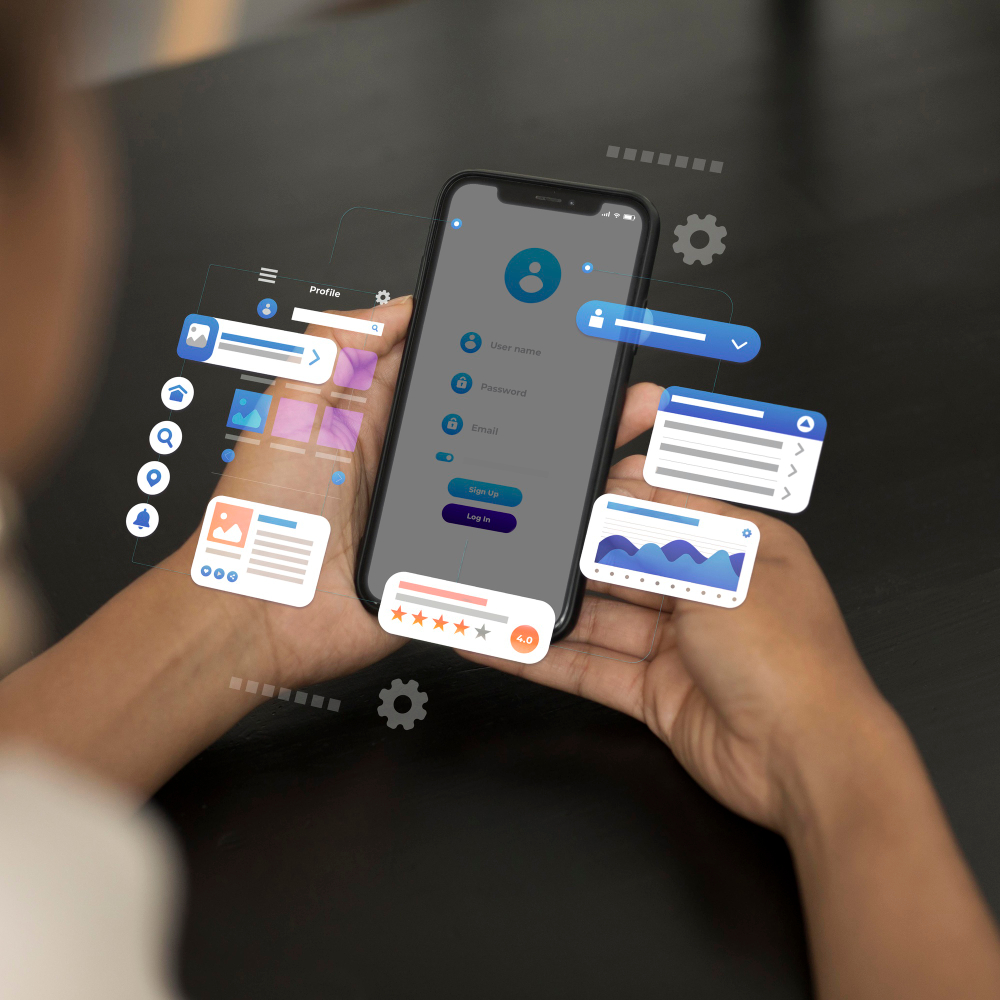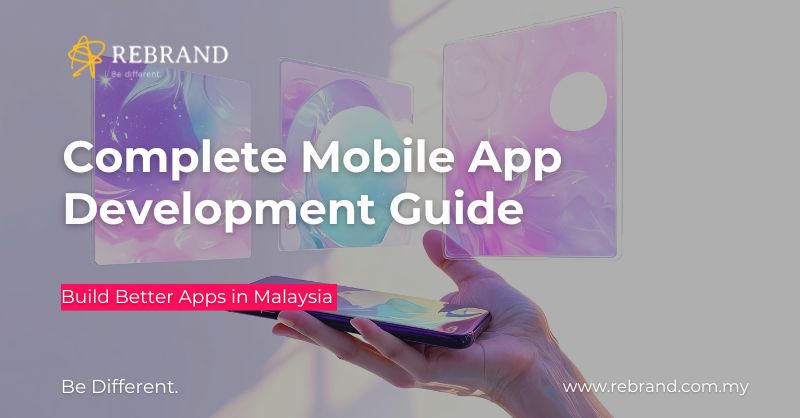Smartphones have become an integral part of life for more than 78% of people worldwide. Android systems power about 70% of these devices. The mobile application development market has seen steady growth over the last several years, which creates amazing opportunities for developers and businesses.
Mobile app development presents its own set of challenges. Web applications are easier to build than mobile apps because each platform needs specific design considerations. On top of that, native app creation requires different coding languages for each operating system. The app economy has shown remarkable growth in various regions. European Union’s app sector created around 1.89 million jobs by January 2017.
A clear understanding of the development process is vital to success. Developers in Malaysia and other markets follow six key steps to create mobile apps. These steps include brainstorming ideas, designing UI/UX, developing with appropriate technologies, testing, launching to app stores, and continuous monitoring for improvements. This piece walks you through each phase of creating successful mobile applications in 2025.

Validating Your App Idea in 2025
App idea validation has become vital to success in 2025. Mobile users spend a combined 4.2 trillion hours on apps yearly. Consumer spending has hit MYR 669.96 billion for the first time. The hard truth is that 9 out of 10 startups fail because nobody wants what they’re selling. Let’s see how you can make sure people actually want your app.
Define the core problem your app solves
A clear problem statement forms the foundation of every successful mobile app. It shows the gap between what exists now and what should be. Your team needs this to understand what they’re trying to fix. A good problem statement has four main parts:
- Problem Identification – What’s broken and what specific challenges do users face
- Context – Where and when does the problem show up
- Effects – How does it affect costs, time, quality, or user experience
- Relevance – Why fixing this matters to users and stakeholders
You can write your problem statement like this: “[User A] faces [this problem] while trying to [complete this action] in [this context]. This matters because [it causes this impact]”. This method removes any confusion and gives a clear path that helps teams work better together.
Analyze competitors and market demand
You need to study your competition early in app development. Your competitors fall into three groups:
- Leaders – Big players who set the standards
- Niche players – Apps that focus on specific user groups
- Disruptors – New companies that shake up the market
Take a good look at their app listings, websites, and apps. Make a list of their features, pricing, money-making methods, user setup process, and overall experience. User reviews can teach you what works and what doesn’t in your market.
Apps that connect people to real-life experiences are growing fast right now. People feel tired of digital-only interactions and want apps for outdoor activities, grocery shopping, and restaurants. The market keeps changing – just look at how Chinese companies Temu and SHEIN have jumped into retail.
Identify your target audience and platforms
You need to know who benefits most from your solution. Think about these factors:
- Location and cultural background
- Age range and gender
- Income levels and spending habits
- Education and occupation
- Family status and living situation
- How comfortable they are with technology
Create user personas after you nail down these details. These are fictional characters that represent your ideal users. Look at how they behave, which platforms they like, and when they use mobile apps.
Young people might prefer TikTok, while older users often stick to LinkedIn or traditional news sources. Platform choice matters a lot – you’ll need to decide between Android, iOS, or both based on your target users.
These three steps will boost your chances of building something people actually want and that solves real problems in the market.

Designing the User Experience for Mobile in 2025
UX design will make or break your mobile app’s success in 2025. Studies show that users make up their minds about your app in just a few seconds. The first impression is vital to keep users engaged and coming back.
Wireframing with Figma and Adobe XD
Wireframes are the first building block in mobile app design. They work like movie storyboards to map out your app’s interface and structure. Figma and Adobe XD have become the go-to wireframing tools for mobile app development in 2025.
Figma stands out as the top choice thanks to its cloud-based platform and team collaboration features. Teams can work on the same file at once, no matter where they are. The platform’s component system lets designers reuse elements across projects, which speeds up development and keeps everything consistent. On top of that, its auto-layout feature adapts designs to fit any screen size – a great way to get responsive designs right.
Adobe XD shines with its powerful wireframing and prototyping tools, which work best for teams using Adobe Creative Cloud. The platform’s voice prototyping, responsive resizing, and smooth integration with Photoshop and Illustrator set it apart. Teams can move from wireframes to detailed mockups without missing a beat.
Creating responsive layouts for foldable and wearable devices
Foldable phones and wearable tech have changed how we think about mobile app design. Foldable devices are unique because they offer both large and small screens. Users can switch between fully open, half-open, or closed states, and each needs its own design approach.
Here’s what you need to remember when designing for foldable devices:
- Build responsive layouts that fit any screen size
- Keep the user experience smooth across screens
- Design smart transitions between different device positions
- Keep interactive elements away from folds or creases
Adaptive layouts work better than just responsive ones. While responsive design adjusts to screen sizes, adaptive layouts create unique experiences for each device state. This means your app will work perfectly whether the device is folded or not.
Accessibility and inclusive design standards
Accessibility isn’t optional anymore – it’s a must-have for mobile apps. The European Accessibility Act will be in full force by 2025, setting clear standards for digital products. Good accessibility creates better experiences for everyone.
The POUR principles guide accessible design: Perceivable, Operable, Understandable, and Robust. These help create apps that work for users of all abilities. Clear navigation, strong color contrast (4.5:1 minimum for standard text), and well-labeled buttons make apps better for everyone.
Real users with disabilities can spot issues that automated tools miss. So, make your app work with screen readers, adjustable text sizes, and multiple ways to navigate. This approach helps meet legal requirements and opens your app to millions more users.

Choosing the Right Development Approach
Developers must make a crucial choice about their development approach when building mobile apps. The tech world changes fast, and this choice affects everything from project timelines to costs and app performance.
Native vs Cross-platform vs PWA in 2025
Native apps deliver outstanding performance and a flawless user experience by tapping into the full potential of specific operating systems. These apps shine when you need resource-intensive functions like games. In spite of that, they have drawbacks – they cost more to develop, take longer to build, and need dedicated developers for each platform.
Cross-platform development has become popular because developers can build apps 50% faster with a single codebase that runs on both iOS and Android. This helps teams launch faster and maintain their apps more easily. Recent numbers show React Native’s growth as the top non-native framework on Apple’s App Store, jumping from 4.73% in 2022 to 6.75% in 2024. Flutter leads the Android space with an increase from 10.15% to 11.07% during this time.
PWAs offer the most economical development path since they work on any device without installation. PWAs might look like mobile app copies with some performance limits, but they update automatically and skip app store approval processes.
Top frameworks: Flutter, React Native, Kotlin Multiplatform
Google‘s Flutter, 8 years old, uses Dart as its programming language and has quickly become 46% of developers’ framework of choice. It takes a unique approach by using its own rendering engine (Impeller) rather than native components, which creates exceptional consistency across platforms. Developers love Flutter’s hot reload feature that shows changes right away without losing app state.
Meta launched React Native in 2015. It uses JavaScript to control native UI elements through a bridge that converts JavaScript logic into platform-specific components. The framework has earned 42% of developers’ trust. Its huge JavaScript ecosystem and use of actual platform UI components create an authentic look and feel.
JetBrains created Kotlin Multiplatform with a different cross-platform philosophy. The framework shares business logic while developers build native UIs for each platform. Android developers have embraced it, with over 60% now using it. They value its code sharing flexibility, type safety, and smooth Android integration.
When to use no-code or low-code platforms
No-code platforms let people build working apps through simple visual editors without coding experience. These tools have improved by a lot, offering many ways to customize while costing about half of traditional development.
Low-code platforms use graphical interfaces where you drag and drop instead of writing code. Teams can build simple to complex applications faster, speed up business digital transformation, and get to market quicker.
No-code or low-code solutions work best when:
- You want to test an MVP faster
- Your budget is tight
- Your app doesn’t need many platform-specific features
- You want non-technical team members to help with development
Your project’s specific requirements, timeline, budget, and performance needs should guide your choice between these development approaches.

Building and Testing Your Mobile App
Your mobile app concept becomes a working reality during the building and testing phase. The app world has changed a lot by 2025. Complex apps and different device ecosystems now make it essential to have a well-laid-out development approach and solid testing.
Frontend and backend development workflows
Today’s mobile app development splits the work between client-side (frontend) and server-side (backend) parts. The frontend handles everything users see and interact with. The backend takes care of data processing, storage, and business logic. Developers now use CI/CD pipelines to make their work easier. These pipelines automatically handle testing, integration, and deployment. This automation helps teams ship new features quickly while the app stays stable and reliable.
API integration and cloud services
APIs connect your app to external services. You should start by getting a full picture of the documentation to understand endpoints, authentication methods, and request formats. You can either use direct HTTPS requests to have more control or go with SDK implementation for an easier setup.
Cloud services have changed the game in mobile app development by giving you ready-to-use infrastructure. AWS Amplify helps build flexible applications that can handle authentication and storage. AWS Device Farm lets you test on actual mobile devices hosted remotely. You won’t need to keep a device lab in your office anymore.
Automated testing tools for Android and iOS
Automated tests help you release faster and test more features. Appium leads the pack as a cross-platform framework that works with many programming languages. You can reuse test scripts for both Android and iOS. Each platform also has its own tools – Espresso for Android (Google’s official testing framework) and XCUITest for iOS (Apple’s native UI testing framework). These native tools run faster and work better with their respective development environments.
Real-device testing vs emulators
Emulators and simulators are handy but they’re nowhere near perfect at copying hardware limits, battery use, or network changes. Real devices give you more accurate test results. Most teams use both approaches – emulators for early testing and real devices for final checks. This mix gives you the best of both worlds – speed and accuracy – so your app works perfectly when it launches.

Launching and Marketing Your App
The launch phase is a crucial milestone after you complete development and testing. Your app’s success in the competitive digital world depends on good preparation and strategic marketing activities.
App Store and Google Play submission checklist
A detailed approach helps you prepare your app for submission. You need to create developer accounts on both platforms. Google Play charges a one-time payment of MYR 111.66 to set up your account. Here’s what you need for a smooth submission:
- App name (limited to 30 characters for Google Play)
- Short description (80 character limit) and full description (4000 character limit)
- High-quality screenshots and app icon (512 x 512 px, maximum size: 1024 KB)
- Privacy policy URL
- App build file (preferably AAB format for Android as it’s smaller in size)
Some developer accounts might need extended reviews that take up to seven days or longer in special cases.
ASO (App Store Optimization) strategies
ASO is crucial since about 63% of iOS users and 58% of Android users find apps through store searches. Here’s what makes ASO work:
Keyword optimization – Research and place keywords strategically in your app’s title, subtitle, and description. Your app’s name carries the strongest ranking weight, followed by the subtitle.
Visual elements – Tell your app’s story with compelling screenshots that include device frames for better visualization. A captivating 30-second video preview can boost conversion rates significantly.
Ratings management – Quick responses to reviews within 24 hours can boost user retention by up to 40%. This shows users you value their feedback and builds your app’s credibility.
Using analytics tools post-launch
Google Analytics offers free, unlimited reporting for up to 500 distinct events. The SDK captures key metrics about user behavior automatically and helps you make smart decisions about product optimization. Notable features include:
- Immediate reporting with StreamView for live data visualization
- DebugView to verify analytics instrumentation
- Custom audience segmentation based on device data and user behavior
Collecting user feedback and planning updates
User feedback creates the foundations for continuous improvement. In-app feedback collection makes it easier for users to share their thoughts. Here’s what you should do:
- Create multiple feedback channels for easy assistance
- Address user reviews quickly to increase satisfaction
- Guide unhappy customers to your message center instead of the app store
- Schedule regular updates to fix bugs and improve features
Regular updates show users that the core team actively maintains the app. Release your first update within a few weeks of launch to handle initial feedback. Monthly updates help maintain quality and improve ratings afterward.
Conclusion
Mobile app development has changed as we move toward 2025. Developers and businesses need to excel in multiple disciplines to launch successful apps. This piece explores the complete path from concept to market presence.
Your app idea needs proof before you invest resources. A clear problem statement, competitor analysis, and target audience definition will boost your market success chances. Understanding what users want helps avoid building unwanted solutions.
Good user experience design creates engaging applications. Figma and Adobe XD have become go-to wireframing tools. Modern layouts must work with foldable devices and wearables. Accessibility has moved from optional to required, both legally and ethically.
Your choice of development approach shapes project timelines and costs. Native development gives better performance but needs platform-specific skills. Flutter and React Native let you deploy to multiple systems faster. Progressive Web Apps offer affordable solutions for simple applications.
Building and testing need efficient workflows that keep frontend and backend separate. API integration links your application to key services. Testing on emulators and real devices proves quality. This balanced strategy ensures reliable performance at launch.
App launch needs careful app store submission prep, strategic ASO, and analytics tracking. User feedback becomes the life-blood of improvement through regular updates.
The digital world keeps changing faster. Developers must adapt to succeed. Staying current with new technologies, user expectations, and market trends will determine which apps succeed in this competitive space. With this complete guide, you can direct each development stage and bring your app vision to life in 2025 and beyond.
Ready to Launch Your App?
You’ve seen how mobile app development in 2025 demands innovation, design excellence, and strategic execution—from validating your idea to launching and scaling. Now is the time to turn your vision into reality.
Contact us today to embark on this exciting journey of growth and success.
Your brand and business deserve their very own story.
Check out our portfolio:
Get a FREE 30-minute consultation with Rebrand Malaysia Now!
Subscribe to our newsletter to always be up-to-date with the latest online marketing trends and insights!
Call us at : 011-3957 0709
Email us at: [email protected]
WhatsApp: https://wa.link/razoe6
- Mobile App Development: The Ultimate Guide - July 28, 2025
- SEO Malaysia Guide 2025: What Actually Works - July 25, 2025
- PPC Agency Secrets: How Top Firms Cut Ad Waste & Double ROI - July 22, 2025



